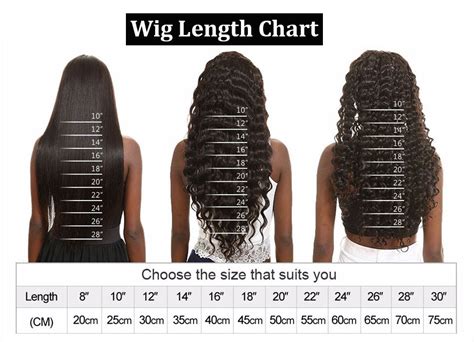Navigating the world of wigs can be daunting, with countless options varying in length, style, and texture. To make the process easier, we present a comprehensive wig length chart that caters to diverse preferences and hair goals. This guide explores the advantages and disadvantages of different wig lengths and provides valuable insights to help you choose the perfect fit.

Wig Lengths Demystified
Wig lengths are typically measured from the crown of the head to the ends of the hair. The following table provides a detailed classification of wig lengths in inches and corresponding centimeters, along with their common names:
| Length (inches) | Length (centimeters) | Name |
|---|---|---|
| 6-8 | 15-20 | Ultra-short |
| 10-12 | 25-30 | Short |
| 14-16 | 35-40 | Medium |
| 18-20 | 45-50 | Long |
| 22-24 | 55-60 | Extra long |
| 26-28 | 65-70 | Extra-extra long |
Choosing the Right Wig Length
Selecting the optimal wig length depends on several factors, including your personal style, face shape, lifestyle, and hair goals. Consider the following questions to guide your decision:
- What is your face shape? Shorter wigs (6-12 inches) can flatter round or square faces, while longer wigs (18+ inches) can elongate oval or heart-shaped faces.
- What is your preferred style? Ultra-short and short wigs (6-12 inches) exude a chic and edgy vibe, while medium to long wigs (14-24 inches) offer versatility and can be styled in various ways.
- What is your lifestyle? Consider your daily routine and activities. Shorter wigs are easier to manage and maintain, while longer wigs may require more care and styling.
- What are your hair goals? Are you seeking a subtle change or a dramatic transformation? Different wig lengths can create different effects, from adding volume to completely altering your look.
Advantages and Disadvantages of Different Wig Lengths
Ultra-Short (6-8 inches)
-
Advantages:
- Low-maintenance and easy to style
- Creates a bold and edgy look
- Ideal for warmer climates or active lifestyles
-
Disadvantages:
- May not provide enough coverage for all hair types
- Can be less versatile for different styling options
Short (10-12 inches)
-
Advantages:
- Versatile and can be styled in various ways
- Flattering for many face shapes
- Provides more coverage than ultra-short wigs
-
Disadvantages:
- May not be long enough for desired hair goals
- Can be challenging to maintain if hair is thick or curly
Medium (14-16 inches)
-
Advantages:
- Provides ample length for a range of styles
- Perfect for those seeking a subtle volumizing effect
- Ideal for everyday wear and formal occasions
-
Disadvantages:
- May not be long enough for dramatic transformations
- Can be heavier than shorter wigs
Long (18-20 inches)
-
Advantages:
- Allows for a wide range of styling possibilities
- Creates a flattering and feminine look
- Can conceal or enhance natural hairlines
-
Disadvantages:
- Requires more care and maintenance
- Can be heavy and uncomfortable for extended wear
Extra Long (22-28 inches)
-
Advantages:
- Provides maximum length for dramatic transformations
- Creates a luxurious and glamorous effect
- Can help achieve a more feminine or princess-like look
-
Disadvantages:
- Most expensive and time-consuming to maintain
- Can be overwhelming and cumbersome for smaller frames
Conclusion
Choosing the perfect wig length is a personal journey that requires careful consideration of your unique needs, preferences, and lifestyle. Use the wig length chart as a guide, and don’t hesitate to consult with a professional stylist for personalized advice. Remember, confidence comes from embracing your authentic self. Whether you opt for an ultra-short pixie or an extra-long mermaid mane, finding a wig that complements your style and empowers you is essential.
